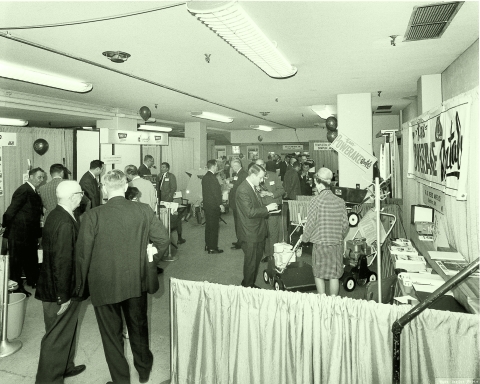The Rental Show: From “Experiment” to World-leading Show

What began as an experiment in the 1950s to see how American Rental Association (ARA) members and rental store owners would respond has now become the largest equipment rental trade show in the world.
It all started in January 1956, when 29 rental operators gathered in a Kansas City, Mo., restaurant for their first Annual Meeting. January was chosen because it was the slow season for rental business, and members
could more easily be away from their stores.
The following year, the meeting expanded to include a trade show with eight exhibitors and about 100 attendees in an Omaha, Neb., hotel. Exhibits were set up in hotel rooms with beds removed, while nearby meeting rooms held sessions on newspaper advertising, accounting controls, and procurement.
The 1958 show in Denver saw a significant increase in both attendance (around 300) and exhibits (41). Registration cost $7.50 for members and $12.50 for non-members.
By the time of the 10th annual convention in Washington, DC in 1966, there were more than 180 exhibitors and approximately 1,500 attendees. It was one of the 10 largest in the U.S. in terms of space that year.
The first time the event was held in a convention center was the 1969 show in Las Vegas. There were 200 exhibitors, including 11 outdoors. A new “mini-theater” was added where attendees could watch movies on equipment maintenance and operations.
The 25th annual convention in 1981 in Las Vegas had one of the highest turnouts in ARA history, even in the shadow of both a poor economy and the tragic fire at the MGM Grand (the headquarters hotel) only two months
before.
In 1986, the show floor was divided into five areas: Party/Medical/Exercise, In and Around the Home, Light Contractor, Heavy Construction/Industrial, and Service. In 2003, the “Rental Product Premiere” featured 34 new products in a movie premiere-type setting. The convention officially became known as The Rental Show in 2004.
The Rental Show has a long history of connections to famous people. In 1959, President Dwight Eisenhower sent greetings via telegram from the White House for the show in Kansas City. President Lyndon Johnson did the same when the show was held in Fort Worth in 1964. Chicago Mayor Richard Daley attended the breakfast in 1962. Singers Helen Reddy and Ray Charles, comedian Danny Gans, and actress Kim Hunter have all played a part in the event over the years. Barbara Bush was keynote speaker at the 50th event in Orlando in 2006.
George Gallup Jr., president of the Gallup Organization, gave the closing address at the convention in Phoenix in 1977. His presentation included results of a Gallup Poll on the equipment rental industry.
Over the past six decades, the convention has grown and changed – much like the rental industry itself. “In the mid-1950s, when ARA was founded and the convention began, rental equipment consisted of all kinds of tools, tractors, beds, baby equipment, home medical equipment, and party items, and most rental stores carried all those items,” said Christine Coleman, ARA director of marketing.
She added, “Today there’s more specialization, with some rental stores just offering construction equipment or party/special event items. The general rental store is still out there too, just not as common as it used to be.”
But what hasn’t changed is the three core reasons for meeting: to view and purchase new products, gain rental-specific education, and to meet and connect with rental peers. Coleman attributes the show’s growth and
success to continued support from ARA members and exhibitors.
“We have many long-term and very loyal exhibitors – over 25 companies have exhibited for 50 or more years,” Coleman said. Clarke, a floor care equipment manufacturer, has exhibited at every show, and Ground Hog has showcased their construction equipment for 59 years.
The 60th anniversary event earlier this year featured “ARA’s Route 66”, with historical displays of association presidents, Rental Hall of Fame members, and convention locations. There were also six decade-specific
videos, each with show photos and relevant music. (www.therentalshow.com/Videos)
The 2016 edition of The Rental Show in Atlanta attracted 665 exhibitors and 11,412 attendees from more than 40 countries. The 2015 show was ranked as #72 on the TSNN Top 250 U.S. Trade Shows list.


Add new comment